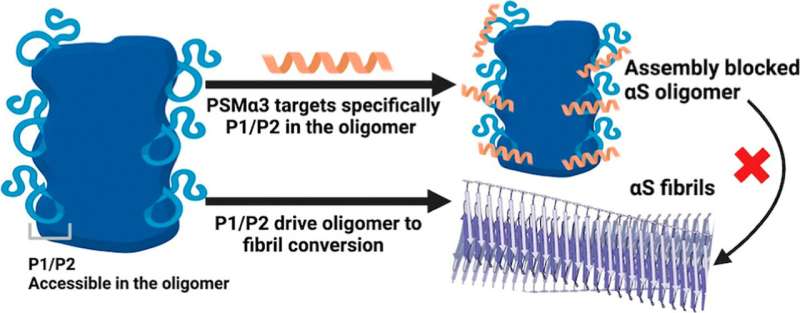
Researchers from the UAB have identified a region in the early aggregates of the alpha-synuclein protein that can be targeted to prevent its conversion into the toxic amyloid fibrils that accumulate in the brains of people suffering from Parkinson’s disease.
The discovery was recently published in the Journal of the American Chemical Society, in a study that advances the comprehension of the structural properties of these initial aggregates, or oligomers, and opens the door to developing new therapeutic strategies for their inactivation.
The study was carried out by researchers Salvador Ventura, Jaime Santos, Jordi Pujols and Irantzu Pallarès from the Institute of Biotechnology and Biomedicine (IBB) and the Department of Biochemistry and Molecular Biology.
Alpha-synuclein aggregation is a hallmark of Parkinson’s disease and other synucleinopathies. It is a dynamic process in which the protein self-assembles to form oligomers that eventually develop toxic amyloid fibrils, which accumulate in the patient’s brain.
Alpha-synuclein oligomers play a key role in the development and progression of the disease and, therefore, are promising therapeutic and diagnostic targets, particularly in the early stages of the disease, but their transient and highly dynamic nature limits the study of their structure and hinders the development of therapies aimed at blocking them.
Researchers had observed in a previous study that a small molecule, the bacterial peptide PSM?3, inhibited the aggregation of alpha-synuclein in binding to oligomers, blocking the conversion to fibrils and inhibiting neurotoxicity. In this study, they identified where, how and when this binding occurs in the oligomers, uncovering a key region for the structural conversion process associated with the pathogenesis of Parkinson’s disease.
“We identified the structure’s sequence that is essential for the conversion of oligomers to fibrils, thus opening a new field of exploration in the design of molecules aimed at targeting oligomers. By leveraging this region, we can develop new molecules that mimic the properties of PSM?3 with a much higher affinity and efficacy,” explains Ventura, director of the Protein Folding and Conformational Diseases Research Group at the IBB and coordinator of the study.
By combining structural, biophysical and biochemical analyses, researchers observed that PSM?3 acts by binding to one end of the alpha-synuclein (N-terminus) that regulates the oligomer-to-fibril conversion process. Upon binding, the peptide covers two small adjacent regions of the protein, P1 and P2, which have been found to be critical for this pathogenic transition.
“This region is an ideal therapeutic target, because it is only recognized by peptides when it is part of the oligomers; this allows us to target the aggregates without impacting the functional monomeric form of alpha-synuclein, which is necessary for proper brain function,” states Ventura.
A relevant region for familial Parkinson’s disease as well
The study was also relevant in delving deeper into the molecular mechanisms behind familial Parkinson’s disease. This variant, which usually affects people of a younger age, is frequently associated with mutations located within the P2 region of the alpha-synuclein, such as the G51D mutation, which produces one of the most aggressive forms of the disease.
Researchers demonstrated that the G51D mutation in the identified critical region causes conformational fluctuations that delay the oligomer-to-fibril conversion. This delay would be the cause of an accumulation of toxic, long-lived oligomers that are not efficiently processed by the molecular chaperones that try to keep them disaggregated.
Instead, they capture essential elements from this disaggregation machinery that are necessary for the correct functioning of neurons. The evasion or deterioration of the correct functioning of the protein control machinery could explain why this and other hereditary mutations cause the early onset of Parkinson’s disease, at an age at which it is assumed that protein homeostasis should be preserved.
“Our discovery could lead to the development of specific peptides that can target these mutated forms of alpha-synuclein and, therefore, a personalized therapy approach for those suffering from familial Parkinson’s disease. We are already working on developing these molecules,” Ventura says.
More information:
Jaime Santos et al, A Targetable N-Terminal Motif Orchestrates ?-Synuclein Oligomer-to-Fibril Conversion, Journal of the American Chemical Society (2024). DOI: 10.1021/jacs.4c02262
Citation:
Therapeutic target identified to neutralize toxic forms of Parkinson’s-associated protein (2024, May 6)
therapeutic-neutralize-toxic-parkinson-protein.html
.
. The content is provided for information purposes only.
